|
Your path =Home>Ancient Beads> Middle East > Berenike Pictures
Berenike Excavation, 2001
The Eastern Desert of Egypt, along the Red Sea
|
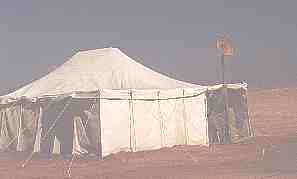
|
|
We were pleased to learn that the camp had been set up by the time the first group of excavators and specialists arrived. This spared us all the work of putting up tents, etc. The satellite dish in front of the mess tent was a big surprise. Unfortunately, as it was just a large basket, it didn't facilitate communication.
|
|

|
|
Overview of the camp from the west. The single building is for storage, office and specialists' workrooms. Photocells on the roof make it the only electrified place around. My tent (fourth from the right) is obscured by the shower tent. The main mound is in the background.
|
|

|
|
The pottery tent (first one on the left in the last photo) was always a beehive. Specialists led by Roberta Tombler catalogued the ceramics, giving the rest of us good chronology with which to work.
|
|
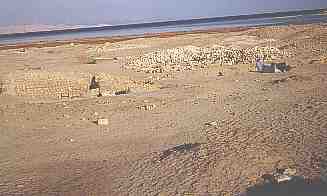
|
|
A section of the main mound. A large street runs from lower left to upper right. Several shops (two-storied for the owners to live above) have been excavated along the street. Some of the shops had parts of small scales, indicating the sale of small, precious items like spices or gems. Or beads?
Evidentially, not all goods were immediately transported to the Nile Valley. Berenike may have been some sort of emporium at one time.
|
|
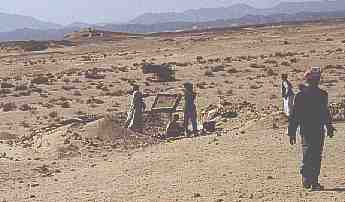
|
|
One task at each trench was to sieve the dirt with a fine mesh as it was dug. Unhappily, this is not done at all excavations. As far as I was concerned, it paid off handsomely because even the tiniest beads were recovered.
The mountains in the background separate the Eastern Desert from the Nile Valley. All along the nearest range are the ruins of Roman forts and towers close enough to each other to send a light signal all along the road that connected Qift (Koptos) on the Nile to Berenike.
|
|
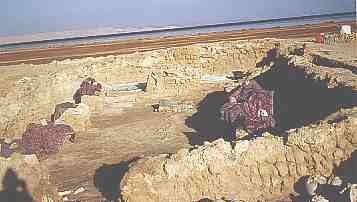
|
|
This section was first opened in 1998, when a cooking area was found next to a small room with benches along its walls. We assumed it was a restaurant for the sailors, and even joked that it might be a brothel.
But it was a far larger structure, with two rows of massive pillars (cloth is draped on them to protect them). There was much debate about what the complex was, but the base of an alter (center), a large bronze cross and several oil lamps with Christian motifs convinced everyone that it was a church.
Beyond the structure, the brown mud flats leading to the Red Sea were not there in ancient times and the church stood imposingly at the edge of the port. This is the third religious building found at Berenike.
We now believe this is the most southeasterly church to be discovered in the Roman Empire.
|
|
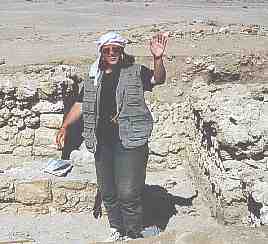
|
|
Iwona Zych of Poland was assigned this trench on the western side of the site. The first thought was that it might have been a gateway to the city since it was in direct line to Hadrian's Road. However, it turned out to be a mortuary.
|
|
|

|
There were a couple of burials and an empty tomb in this trench. The most poignant was that of an infant.
|
|
Another shot of the same burial
|
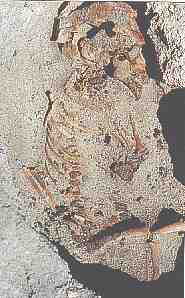
|
|

|
The baby was wearing a bracelet of blue and white biconical and oblate folded glass beads. At its neck was another bead, a no-doubt expensive large agate oblate from India.
There was one other burial that had beads. It was a cat lovingly entombed in a pot with blue faience beads with very thick glaze.
|
|
Excavations at Berenike, Egypt, text
__________________________________________________
Small Bead Businesses | Beading & Beadwork | Ancient Beads | Trade Beads
Beadmaking & Materials | Bead Uses | Researching Beads | Beads and People
Center for Bead Research | Book Store | Free Store | Bead Bazaar
Shopping Mall | The Bead Auction | Galleries | People | Events
The Bead Site Home | Chat Line | Contact Us | Site Search Engine | FAQ
|









